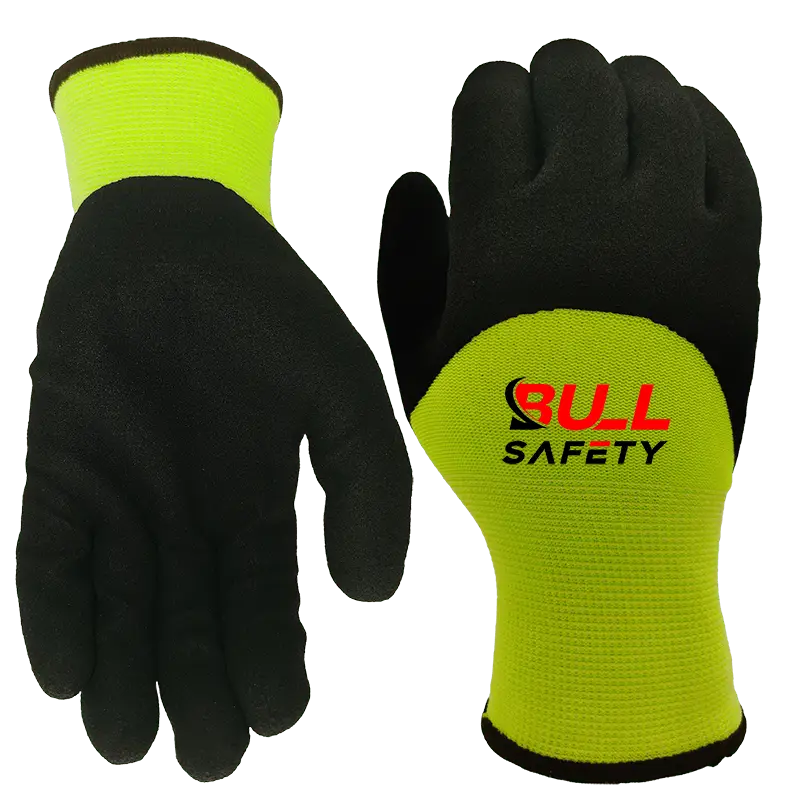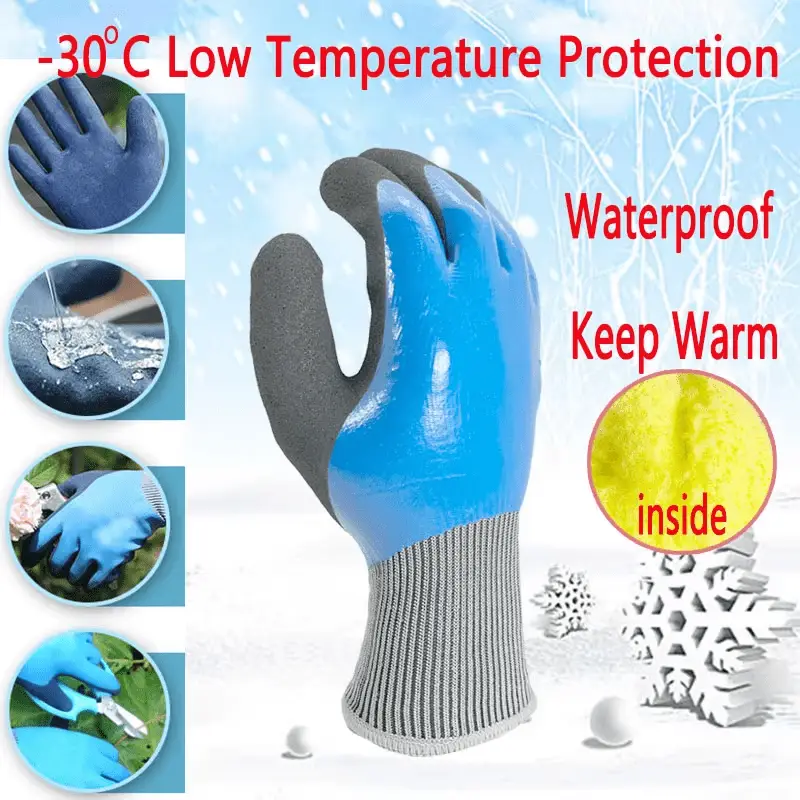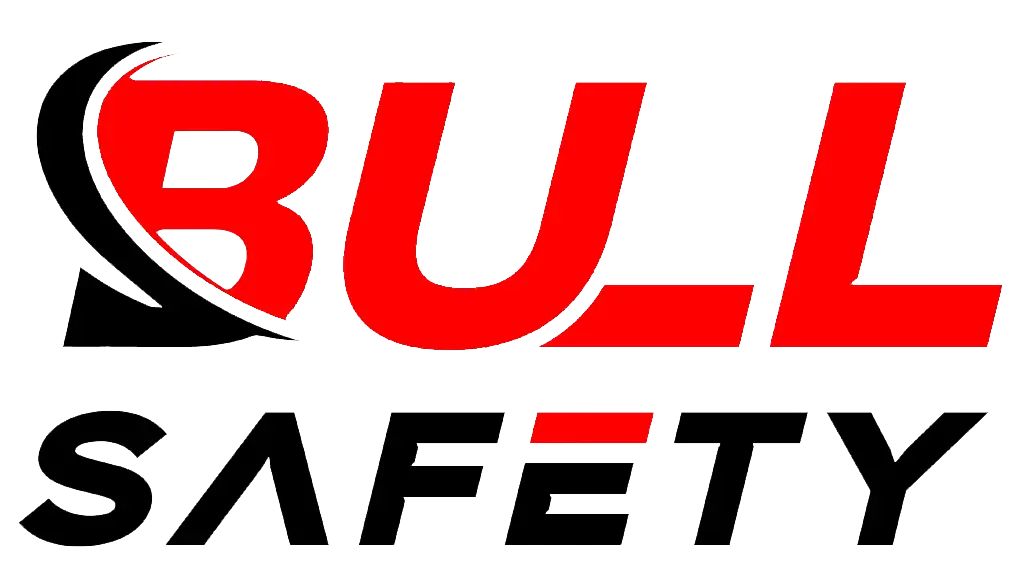
When it comes to safety in cold environments, it’s not just about keeping warm. Cold-resistant gloves that meet the EN 511 standard offer critical protection from freezing temperatures, and understanding what this standard involves is essential for making informed purchasing decisions.
The EN 511 standard specifies the performance criteria for cold-resistant gloves, assessing their ability to protect against contact cold, convective cold, and water resistance1, ensuring the gloves are reliable in freezing conditions.
Whether your business deals with outdoor workers2, manufacturing environments, or construction sites, knowing the details of EN 511 will help you choose the right gloves that provide reliable protection and compliance with European standards3.
What is the EN 511 standard?
The EN 511 standard is a key regulatory framework for cold-resistant gloves.The EN 511 standard sets the guidelines for gloves that are intended to protect hands from cold environments, testing for factors like resistance to contact cold, convective cold, and water penetration.
 BULLSAFETY THERMAL GLOVES FUCTION
BULLSAFETY THERMAL GLOVES FUCTION
The EN 511 standard4 is essential for assessing gloves used in cold environments, particularly for industries where workers are exposed to freezing temperatures or cold materials. It ensures that gloves are tested under strict conditions to verify their protection against cold-related injuries. The standard covers several aspects of glove performance5, including resistance to both convective cold (cold air) and contact cold (cold surfaces), as well as waterproofing.
What Does EN 511 Measure?
EN 511 evaluates cold-resistant gloves6 on three main factors:
| Performance Test | Description | Rating Scale |
|---|---|---|
| Resistance to Convective Cold | The ability of the glove to protect from cold air exposure. | 0-4 |
| Resistance to Contact Cold | The glove’s ability to protect against cold surfaces (e.g., metal or ice). | 0-4 |
| Waterproofing | The glove’s resistance to water penetration. | 0-3 |
1. Resistance to Convective Cold
This test measures how well a glove protects against cold air. The higher the rating, the better the glove prevents the transfer of cold air to the skin. A Level 0 rating indicates no protection, while Level 4 offers the highest possible resistance. For workers who spend extended periods in outdoor or refrigerated environments, a higher rating is crucial.
2. Resistance to Contact Cold7
This test evaluates the glove’s ability to protect against direct contact with cold surfaces. For example, a worker handling frozen metal or materials at low temperatures needs gloves that can prevent the cold from transferring to the hands. Gloves rated 4 can offer protection down to temperatures as low as -50°C.
3. Waterproofing
Waterproofing8 is vital for preventing cold water or snow from penetrating the glove, which could exacerbate cold-related injuries. The waterproof test evaluates whether the glove keeps the hands dry in wet conditions, such as in a wet, freezing environment. The ratings for waterproof performance range from 0 (no waterproof protection) to 3 (fully waterproof).
What is the temperature for EN 511?
Temperature is one of the most critical factors when evaluating cold-resistant gloves. But exactly what temperatures does the EN 511 standard cover?
EN 511 evaluates gloves based on their ability to protect against both convective and contact cold, with temperature ratings9 that range from mild cold to extreme freezing conditions as low as -50°C.
Temperature protection is one of the core features of EN 511, and understanding the temperature ranges associated with the various ratings can help ensure you’re choosing the right glove for the conditions your workers face. The EN 511 standard categorizes gloves according to their performance in extreme cold, both from environmental exposure and contact with cold surfaces.
Temperature Ratings in EN 511
The temperature resistance is categorized into two main areas:
-
Convective Cold (Cold Air Exposure)
This tests how well the glove blocks cold air from reaching the skin. Workers exposed to outdoor cold or in refrigerated storage areas need gloves with high protection against convective cold. -
Contact Cold (Direct Cold Surface Contact)
This tests how well the glove prevents cold from transferring from direct contact with frozen materials or equipment. Depending on the environment, gloves must offer protection against extremely cold surfaces, such as metal or concrete exposed to subzero temperatures.
Temperature Resistance Breakdown
| Rating | Convective Cold Protection | Contact Cold Protection |
|---|---|---|
| Level 0 | No protection | No protection |
| Level 1 | Protection down to 0°C | Protection down to -5°C |
| Level 2 | Protection down to -5°C | Protection down to -10°C |
| Level 3 | Protection down to -15°C | Protection down to -20°C |
| Level 4 | Protection below -15°C | Protection below -50°C |
Application in Real-World Environments
For industries like logistics or construction in cold climates, choosing gloves with high resistance to both convective and contact cold is crucial. For example, if workers handle frozen materials directly, gloves rated Level 4 for contact cold10 provide necessary protection. Similarly, for outdoor workers in freezing weather, gloves that block cold air (Level 4 for convective cold) are vital to avoid frostbite or other cold-related injuries.
What is the EN 511 test?
Understanding the EN 511 test itself is essential for choosing gloves that meet the required standards for cold protection. Let’s explore the testing process in detail.
The EN 511 test evaluates gloves for resistance to cold11, testing their performance under controlled conditions for contact cold, convective cold, and waterproofing.
The EN 511 testing procedure is designed to evaluate how well gloves perform under a variety of cold-related scenarios. Gloves are tested for both their ability to block cold from the air and direct contact with freezing surfaces. The test also ensures that the gloves maintain their integrity in wet conditions, as water penetration can worsen cold exposure.
Breakdown of the EN 511 Testing Process
The testing process involves several steps, each critical for ensuring that gloves meet the required safety standards:
-
Testing for Convective Cold Resistance
The gloves are exposed to a controlled airflow of cold air, and the temperature at which the glove begins to lose its protective capabilities is measured. Gloves are then rated based on this exposure. -
Testing for Contact Cold Resistance
In this test, gloves are placed in direct contact with cold materials, such as frozen metal or ice, to evaluate how well they protect the hands from direct contact with freezing surfaces. Gloves that maintain their insulating properties during this test receive higher ratings. -
Waterproof Testing
A waterproof test is conducted to measure how well gloves prevent water from entering. Waterproof gloves are particularly important for workers who are exposed to wet conditions in cold environments, such as those working in refrigerated storage or in rainy, freezing conditions.
Factors Affecting Test Results
Several factors can influence the results of EN 511 tests, including glove material, thickness, and construction. For example, gloves made from thick, multi-layered materials may perform better in terms of contact cold resistance but might score lower in waterproof tests if the seams or coatings are not adequately sealed.
FAQ about EN 511
Here are some of the most common questions about EN 511, helping you understand the standard and how to select the best cold-resistant gloves.
From rating systems to application scenarios, this FAQ section answers common questions about the EN 511 standard and cold-resistant gloves.
1. What is the highest protection level for cold-resistant gloves under EN 511?
The highest level of protection under EN 511 is Level 4. This indicates maximum resistance to both contact and convective cold, suitable for extreme environments where temperatures drop below -50°C.
2. Why is EN 511 Certification Important for Thermal Gloves?
EN 511 certification ensures that thermal gloves meet specific performance criteria related to insulation, wind resistance, and water resistance. This certification provides consumers and professionals with confidence that the gloves will perform effectively in cold environments, enhancing safety and comfort.
3. What are the Key Requirements of EN 511 for Thermal Gloves?
EN 511 outlines several critical requirements for thermal gloves, including:
- Thermal Protection: Measures the glove’s ability to protect against cold temperatures.
- Wind Resistance: Evaluates how well the glove resists penetration by wind, which can significantly affect thermal performance.
- Water Resistance: Assesses the glove’s ability to prevent water ingress, which can compromise insulation.
- Breathability: Ensures that moisture vapor can escape from the inside of the glove to prevent sweat accumulation.
- Dexterity: Guarantees that gloves allow sufficient movement and functionality for tasks in cold environments.
4. How is Thermal Protection Tested According to EN 511?
Thermal protection in EN 511 is typically assessed using a thermal manikin or other standardized testing methods that simulate cold exposure. The gloves are evaluated based on their ability to maintain hand warmth over a specified period under controlled temperature and wind conditions.
5. What Are the Different Classes of Thermal Gloves Under EN 511?
EN 511 classifies thermal gloves into different classes based on their insulation and protection levels:
- Class 1: Basic protection suitable for mild cold conditions.
- Class 2: Moderate protection for colder environments.
- Class 3: High protection for extreme cold and harsh weather conditions.
Each class defines specific performance criteria that gloves must meet to be certified accordingly.
6. Can I Use Non-EN 511 Certified Gloves in Cold Environments?
While non-EN 511 certified gloves may offer some level of protection, they do not guarantee the same standardized performance as EN 511 certified gloves. For activities in extreme or professional cold environments, it’s recommended to use gloves that meet EN 511 standards to ensure adequate protection and safety.
7. How Do EN 511 Thermal Gloves Compare to Other Standards?
EN 511 is one of several international standards for cold weather protective clothing. For example:
- ISO 11370: Another standard addressing cold protective clothing, similar to EN 511.
- ASTM Standards: In the United States, ASTM provides standards for cold weather gear, which may differ in specific requirements.
EN 511 is widely recognized in Europe and ensures consistency and reliability for users within the region.
8. What Materials Are Commonly Used in EN 511 Thermal Gloves?
EN 511 thermal gloves often incorporate a combination of materials to achieve desired performance, such as:
- Insulating Layers: Materials like Thinsulate, wool, or synthetic fibers to retain heat.
- Outer Shells: Windproof and water-resistant fabrics such as Gore-Tex, nylon, or polyester.
- Lining: Soft materials like fleece or microfiber for added comfort.
- Reinforcements: Areas like palms and fingers may include reinforced materials for durability and grip.
9. How Should I Care for My EN 511 Thermal Gloves?
Proper maintenance extends the lifespan and performance of EN 511 thermal gloves:
- Cleaning: Follow the manufacturer’s instructions, typically involving gentle washing with mild detergents.
- Drying: Air dry gloves away from direct heat sources to prevent damage to insulating materials.
- Storage: Store in a cool, dry place to avoid moisture buildup and material degradation.
- Repairs: Address any tears or damages promptly to maintain protective qualities.
10. Where Can I Purchase EN 511 Certified Thermal Gloves?
EN 511 certified thermal gloves are available through various retailers, including:
- Outdoor and Sporting Goods Stores: Specialized shops often carry a range of certified gloves.
- Workwear Suppliers: Providers catering to professions requiring cold protection.
- Online Retailers: E-commerce platforms offer extensive selections with detailed specifications.
- Manufacturer Websites: Purchasing directly from brands ensures authenticity and access to the latest models.
11. Are There Additional Features to Look for in EN 511 Thermal Gloves?
Beyond meeting EN 511 standards, consider the following features based on your specific needs:
- Touchscreen Compatibility: Allows use of electronic devices without removing gloves.
- Adjustable Cuffs: Ensures a snug fit to prevent cold air and moisture ingress.
- Grip Enhancements: Textured surfaces or reinforced palms improve handling of tools and equipment.
- Helmet Compatibility: Ensures that gloves fit comfortably with protective headgear if required.
12. Can EN 511 Thermal Gloves Be Used for Activities Other Than Cold Protection?
While primarily designed for cold environments, EN 511 thermal gloves can be suitable for various activities that require hand protection from low temperatures, such as:
- Outdoor Sports: Skiing, snowboarding, and mountaineering.
- Industrial Work: Handling cold materials or working in refrigerated environments.
- Emergency Services: Providing thermal protection for first responders in cold conditions.
Always ensure that the gloves meet the specific demands of your activity beyond thermal protection.
13. How Often Should I Replace My EN 511 Thermal Gloves?
The lifespan of thermal gloves depends on usage frequency, environmental conditions, and maintenance. Generally:
- Regular Use: Replace every 1-2 years or when signs of wear and tear appear.
- Heavy Use: May require more frequent replacement due to accelerated material degradation.
- Specialized Use: Gloves used in extreme conditions should be inspected regularly and replaced as needed to ensure ongoing protection.
14. Are There Any Limitations to EN 511 Thermal Gloves?
While EN 511 thermal gloves provide standardized cold protection, they may have limitations:
- Specific Conditions: May not cover all extreme environments; always assess if the gloves meet your specific needs.
- Activity-Specific Needs: Certain activities may require additional features not addressed by EN 511.
- Technological Advancements: New materials and technologies may offer improved performance beyond standard requirements.
15. How Do I Verify If a Pair of Thermal Gloves is EN 511 Certified?
To confirm EN 511 certification:
- Look for Labels: Certified gloves typically display the EN 511 mark on the label or packaging.
- Check Product Specifications: Retail listings and manufacturer websites should mention compliance with EN 511.
- Consult the Manufacturer: If uncertain, contact the manufacturer directly to verify certification status.
Conclusion
The EN 511 standard provides clear guidelines for selecting cold resistant gloves that offer essential protection in freezing conditions. By understanding these ratings and test results, businesses can ensure they are choosing gloves that meet the safety needs of their workers.
-
Clicking this link will help you learn about the different kinds of cold protection—contact cold, convective cold, and water resistance—and how each is evaluated in protective gloves. ↩
-
This link will help you understand the specific requirements for protective gloves in outdoor and hazardous work environments, ensuring safety and compliance. ↩
-
Clicking this link will provide insights on European standards for protective equipment, helping you understand the criteria for selecting compliant gloves. ↩
-
Understanding the EN 511 standard is crucial for ensuring safety in cold environments. Explore this link to learn more about its importance and applications. ↩
-
Measuring glove performance is key to ensuring adequate protection. This resource will provide insights into the testing methods and ratings used. ↩
-
Cold-resistant gloves are vital for worker safety in freezing conditions. Discover their features and how they protect against cold injuries. ↩
-
This knowledge is crucial for ensuring safety when handling cold materials, making it a must-read for workers in cold environments. ↩
-
Exploring this topic will help you understand how waterproof gloves can prevent cold-related injuries, enhancing your safety in wet conditions. ↩
-
Learn about the specific temperature ratings under EN 511 to ensure proper protection against cold conditions. ↩
-
Discover the significance of Level 4 ratings for contact cold to ensure maximum protection for workers handling frozen materials. ↩
-
Learn how resistance to cold is measured to ensure you choose the right gloves for cold environments. ↩



